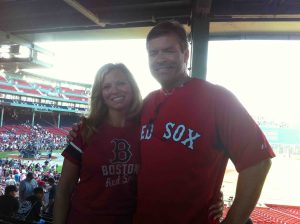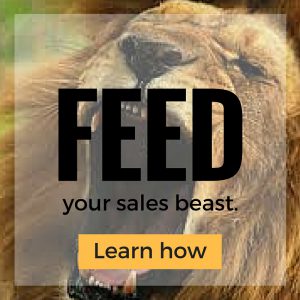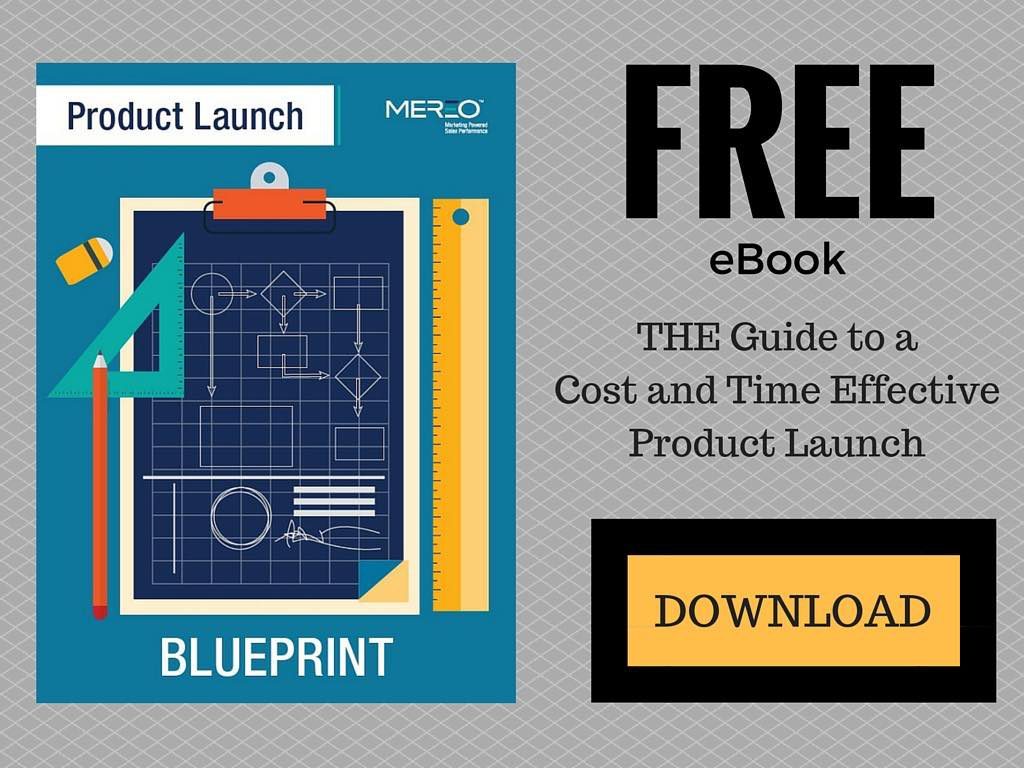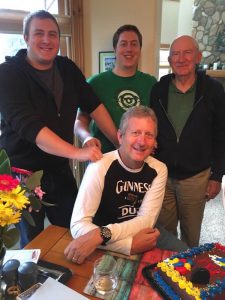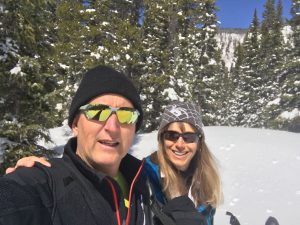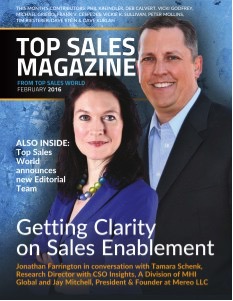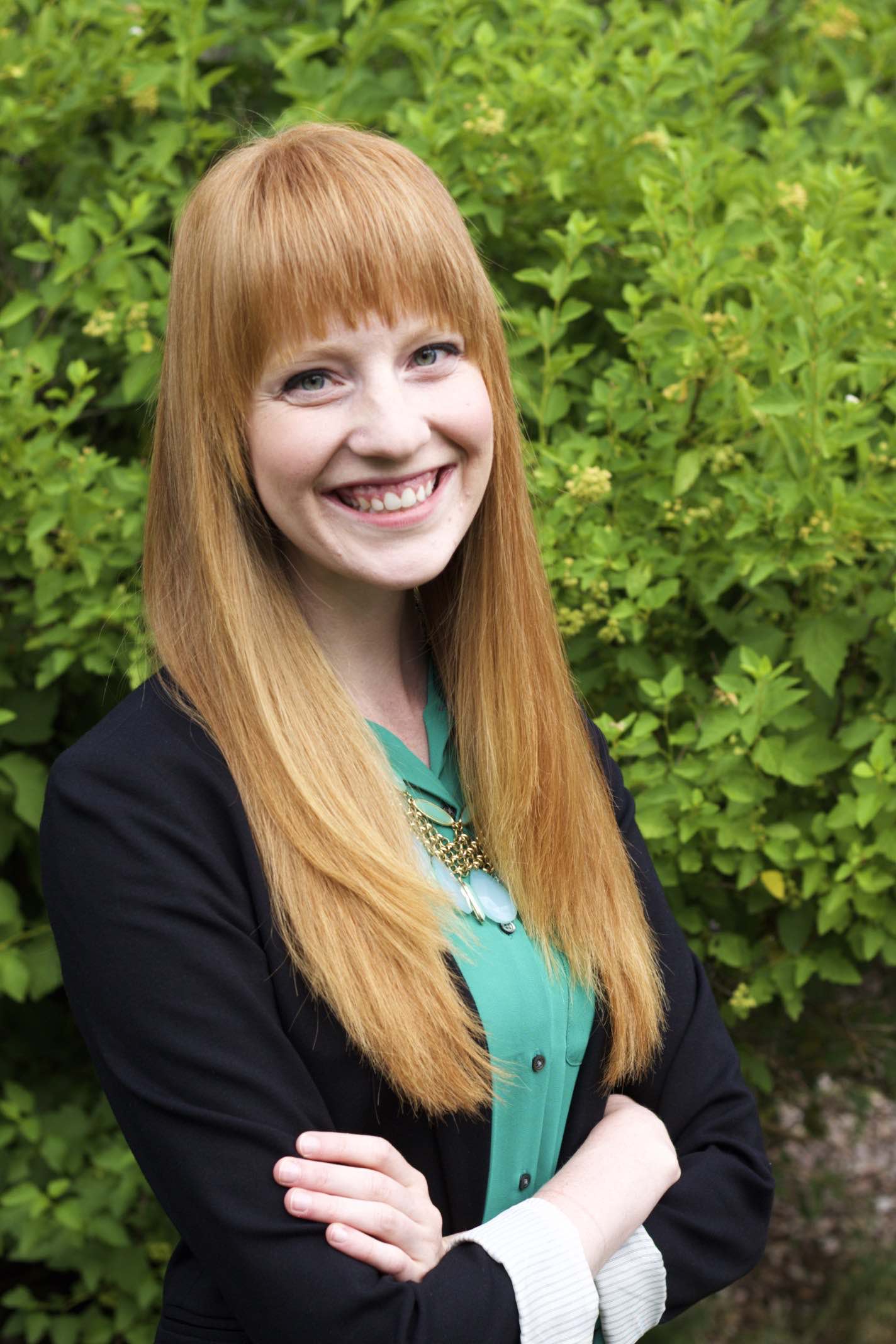This month, founder and President of Mereo, Jay Mitchell, was interviewed by Jonathan Farrington, CEO and co-editor the world-renown sales publication, Top Sales Magazine. Jay was interviewed alongside respected industry leader, Tamara Schenk, Research Director with CSO Insights (a division of MHI Global). Together they provided much needed clarity to the murky waters of sales enablement.
“It was an honor, not only to be interviewed by such an esteemed magazine, and alongside my respected peer, Tamara, but also to be seen as a thought leader on this often-convoluted topic. I hope this interview brings true clarity and tools for success for the readers,” Mitchell commented.
(Get your copy of the magazine here.)
Check out the comprehensive interview below!
Jonathan Farrington: Sales enablement still means many different things to different people. What does enablement really mean and how did it evolve?
Tamara Schenk: Yes, the term “enablement” needs clarification, depending on an organization’s context and current maturity level. But the common ground is to equip sales forces’ ability to evolve their “how to sell” approach according to changed buyer behaviors. That’s why we came up with a new definition:
Sales Force Enablement is a strategic, cross-functional discipline, designed to increase sales results and productivity, by providing integrated content, training and coaching services, for salespeople and frontline sales managers, along the entire customer’s journey, powered by technology.?This definition belongs to the recommended maturity level, what you should be doing. Organizations who are currently focused on either the content or the training stream (required maturity level) should begin to align and integrate their enablement services (“no training without content, no content without training”), based on a solid “customer-core” enablement framework. That means to map the customer’s journey to the internal process landscape before defining the scope of enablement. Then, enablement services can be tailored to different customer’s journey phases, buyer roles, and more.
Jay Mitchell: While there has been a mountain of research done in the last 3-4 years indicating the journey for B2B buyers is shifting, there has been very little talk about selling differently in these changing times. The way many sales professionals sell today is not much different than the B2B selling hey-day of the late 1990s/early 2000s. Why? Because too often sales leaders don’t know what needs to change, don’t have a model for a new approach or don’t know how to equip their sales teams appropriately. At Mereo, we have the honor of working with dozens of organizations trying to embrace the new dynamic of buyer and seller. The most successful of these companies address sales enablement as an operational discipline, rather than an independent function of their go-to-market operations. They employ cross-functional resources to deliver interdependent messaging, sales ready assets, training and coaching to their sales channels in a way that is synchronized with their client’s buying journey.
JF: That’s a comprehensive definition! Let’s look at the goals. What are the specific goals of enablement apart from increasing revenue that lead to sales performance?
JM: For most organizations, the macro objectives are fairly straightforward: to grow profitable revenues and increase quota attainment/revenue delivered per sales professional, while lowering cost of sale. While those are absolutely accurate, the market leaders we serve benchmark sales enablement success by the tenets that power revenue performance – that is, metrics such as elevating average deal size, enhancing the wallet share captured from each client, accelerating the on-boarding window for new sales professionals and shortening the sales cycle.
Beyond those traditional sales metrics, there are some clear measurements of marketing’s impact in sales enablement. For example, a recent CMO Council study revealed sales professionals waste two days per week creating their own messaging and tools. It is no wonder that the inability to communicate value messages to customers and prospects is still the biggest inhibitor to sales success.” Measuring marketing’s contribution to sales enablement may be “softer”, but it is still a fundamental gauge of success.
TS: Our CSO Insights 2015 Sales Enablement Optimization Study (membership required) shows that enablement is a multifaceted discipline with a wide variety of goals of similar importance. Increasing sales efficiency was reported to be the most important goal (82%), which is the equivalent to lowering the cost of sale, as Jay mentioned. The second most important goal was increasing revenue as both of you mentioned (76%), and increasing new account acquisition (69%). The list continues with performance goals such as increasing the win rates, the reduction of sales cycle length and increasing revenue in existing clients. It’s important to understand that enablement goals have two critical dependencies: context and maturity. Context examples are, e.g. a growth path versus defending a market position, disruptions, or tech innovations. All have one in common: they impact and change how buyers want to buy and what’s valuable to them.
JF: The obvious question I have to ask: Where does enablement belong in the organization? In marketing or in sales?
TS: For years, in the absence of data, the question has been “Is enablement in sales or marketing?” Now we have to reframe the question to “where in sales is enablement?” based on the data of our 2015 Sales Enablement Optimization Study. More than three quarters (78%) of all surveyed organizations placed enablement within sales – executive sales management (53%) or sales operations (25%). Only 7% indicated their enablement function to be in marketing while another 15% said enablement reports to various functions such as product/portfolio management, training, HR and others. There is an interesting difference for large organizations, above $250b in revenues: Also here more than three quarters (77%) report into sales, but less to executive management (36%) and more to sales operations (41%). And more of these large organizations have their enablement function within marketing (11%).
JM: As I mentioned earlier, we find that the top-performing organizations view sales enablement as a cross-functional discipline that engages resources (budgets and people) primarily from sales, marketing, solutions/products, services and training. That said, the leadership for the sales enablement team most often resides in sales, either reporting directly to the senior sales executive or to one of his/her chief lieutenants, in many cases sales operations. An important attribute we are finding in many of our clients is the importance sales enablement plays on the radar of the CEO/General Manager. For our most successful clients, when the CEO/General Manager takes a keen interest in the significance of sales enablement to their overall plan, revenue growth naturally follows.
JF: Let’s switch to what enablement teams provide for the sales force. A specific term that’s discussed almost everywhere is the term “playbooks.” For which purposes do I need a playbook, and how does that look like today, in the age of technology?
JM: The backbone of sales enablement is a consistent, well-tuned sales process aligned with the ideal buyer’s journey, as it provides a framework from which the key outputs of a sales enablement platform resonate. We see two key pillars of sales enablement, underpinned by a critical cultural tenet. The first pillar is a value-based messaging framework, which includes the ideal client profile, the pains ideal clients are encountering, discovery questions for igniting those pains and differentiated messages that are not only unique and provable, but also valuable to the audience. Ideally, these value proposition fundamentals are encapsulated in an interactive playbook that serves as a guide for sales to navigate the sales cycle with messaging that supports each conversation. Ultimately, messaging manifests itself in customer-facing, sales ready assets, such as prospecting talk tracks, pencil pitches and even proposal language and presentation templates. Once the messaging – the content – is in place, training sales to use the sales kit in context of their sales process is next. The second pillar of sales enablement – training – includes LOTS of role-plays where applying the messaging and sales kit is modeled and practiced. Which brings us to the critical cultural tenet of sales enablement – coaching. This is the most important facet in a sales enablement program and is predicated on sales managers intentionally learning the messaging, using the tools themselves and then practicing with their team, while providing relevant counsel.
TS: Amen, Jay! The term “playbook” is often as confusing as “enablement.” Playbooks are one of many content services, of course, an important one, mostly used in complex environments. Playbooks are interactive tools that guide salespeople along the entire customer’s journey with the right value messaging, content and sales tools, ideally tailored to any specific buying situation, powered by technology. A playbook is not a big book nobody will ever read. It’s a digital tool that’s ideally created per opportunity, depending on its stage, industry, buyer roles, business challenge, etc. And that requires a solid content management framework that’s designed along the customer’s journey.
We asked the participants of our enablement study to rank enablement services’ effectiveness. Playbooks and other enablement services that have to be designed with the customers at the core were reported rather ineffective compared to “old-fashioned” product sheets or product training services. While organizations made progress in aligning their sales processes to the customer’s journey, there is still a lot to do to translate this advantage into effective “customer-core” enablement services. And that requires a mindset shift.
JF: Enablement cannot be discussed without technology. What’s the state of the industry and what are the trends?
TS: There are many enablement vendors out there, and the market continues to grow. Years ago, you saw lots of enablement point solutions; desktop focused. And just a few years later, enablement solutions are available on any device, mostly integrated with CRM Systems. Furthermore, enablement technology equips salespeople with suggested content and training sessions right at their fingertips, allows them to share content (also videos) with prospects and clients, while customer interactions and buyer behaviors are tracked in parallel, as a foundation for often already integrated coaching features. Furthermore, enablement technology allows content creators (not only marketing) to define and maintain content management frameworks. An aspect that’s often underestimated, but when organizations want to provide tailored content to specific buying scenarios, they have to have a content management framework in place that’s defined along the customer’s journey.
JM: Tamara nailed it. It has evolved from point solutions, to technology purposely used for sales enablement and synchronized with the CRM system. The most effective solutions deliver the messaging, the sales enablement assets and even role-play training at the sales professional’s device – often a tablet or iPad. We have partnered with a number of vendors in this arena, and have seen our clients develop proprietary solutions for it. The established, proven solutions have delivered better results almost every time.
JF: To create all these enablement services, collaboration must be a big challenge and also an important “enabler” for enablement. How does the reality look like?
JM: The biggest obstacle to sales success, according to sales managers, is the sales team’s inability to communicate value messages, based on CSO Insights research. For me, this means too many organizations are not synchronized on the real purpose of sales enablement— to equip the sales channels to create more value in EVERY interaction with a prospect/client. As I’ve already mentioned: sales enablement is a cross-functional discipline that is rooted in an alignment between sales, marketing, solutions/products, services and training as the primary contributors. Alignment is the key word here. When these, often disparate teams are united by a common mission — to enable the sales force to serve their audience first — unleashed revenue performance is guaranteed to be the result.
TS: The survey results on collaboration were as surprising as the question where enablement belongs in the organization. More than 80% of the participants reported to collaborate on an informal (42%) or an ad hoc basis (41%) which means that they have no formal collaboration, collaboration framework or model in place. Only 12 % of the participants reported collaborating on a formal basis. Interestingly, a snapshot on larger organizations delivered the exact same results. In reality, organizations allow themselves NOT to leverage a huge potential for efficiency, which is a prerequisite to achieving sales performance goals. From opinions to data: there is a significant correlation between collaboration and quota attainment. Between those with an ad hoc and a formal collaboration approach, there was a 21% difference in quota attainment. Which sales leader can allow not to leverage such a quota attainment potential?





